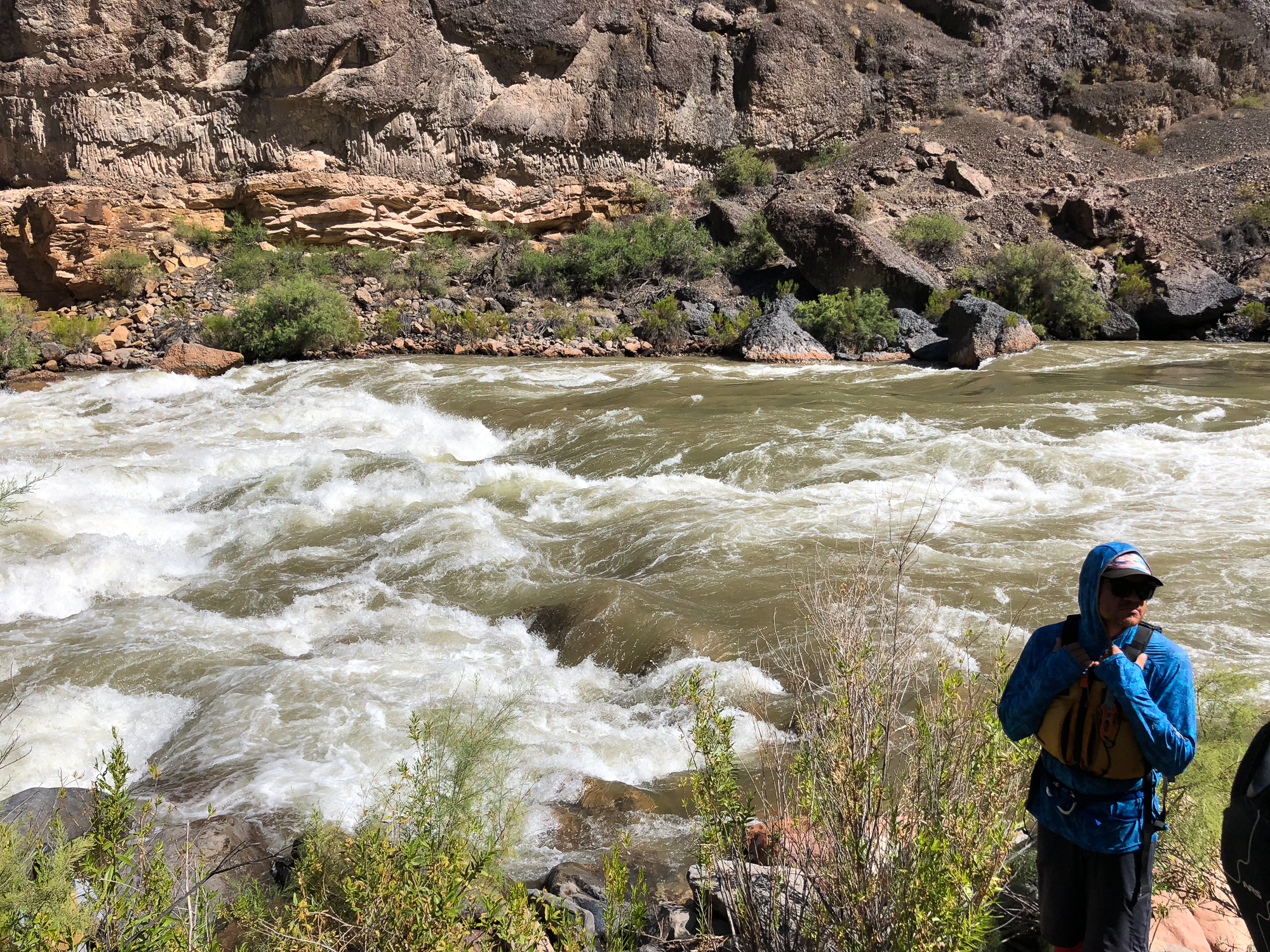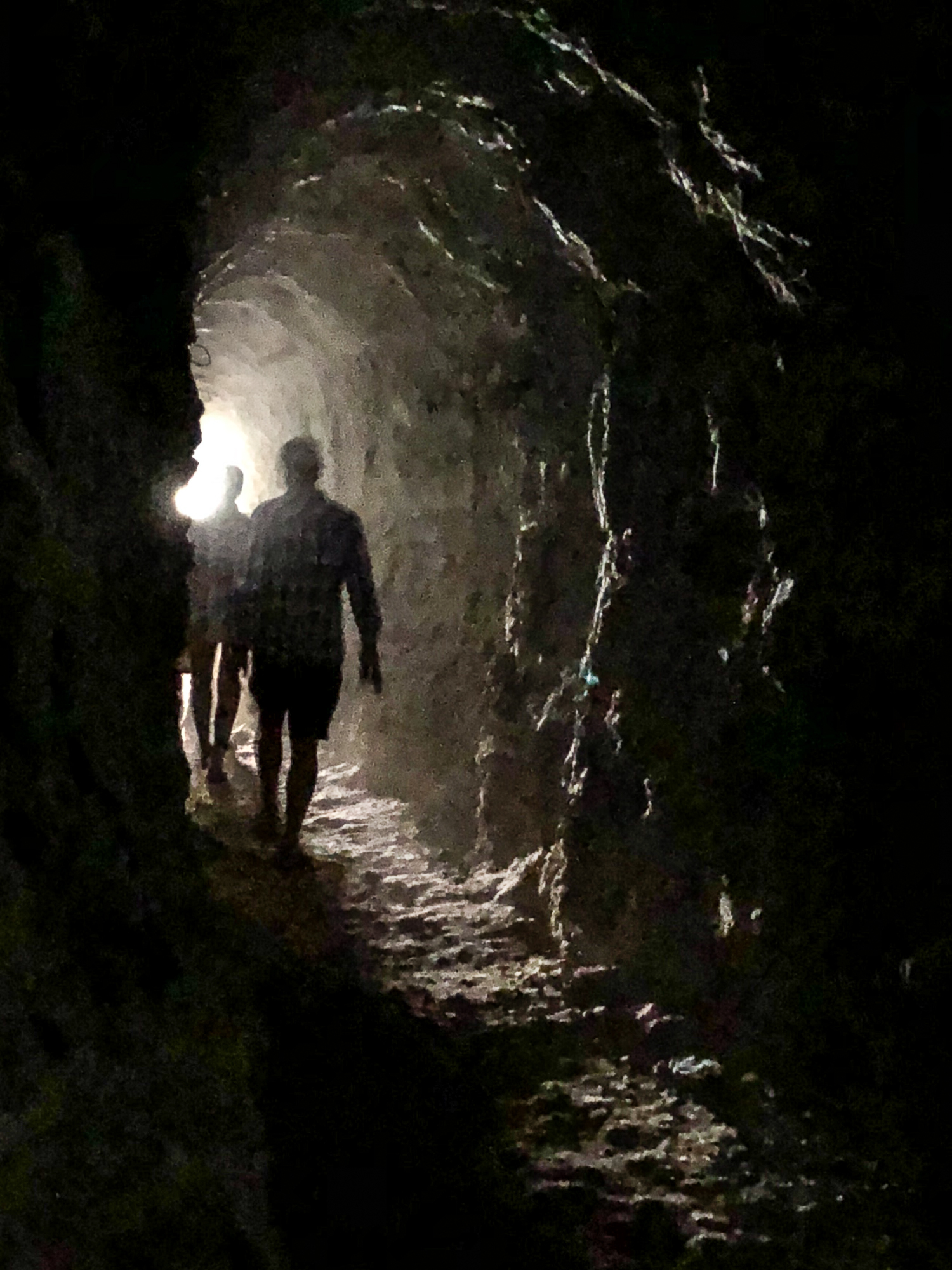Floating 200 miles through the Grand Canyon - 12 Timeless Days - Part 1
“It would be impossible for a boat constructed of any known material, upon any conceivable plan, to live through the canyon. We do not know what kind of boats Professor Powell purposes to descend the Grand Canyon but we greatly fear that the attempt to navigate by any means whatever will result fatally to those who undertake it”
During the Summer of 2018, I joined a group of strangers to float 188 miles down the Colorado River along the bottom of the Grand Canyon. This trip turned into one of the best trips of my life.
Over the course of 12 days, these strangers left the digital world behind and embraced the extremes of the real world at the bottom of the Grand Canyon. The river flows a mile beneath the surface of the earth with air temperatures in the triple digits. We lived as a self reliant group having no contact with the outside world. This crucible of shared intense experience transformed strangers to friends. I will describe this journey with 2 separate posts and hope you enjoy this first part - the 90 mile float to Phantom Ranch.
A note about the photography. I normally bring my Leica to capture images. I decided the harsh environment of sand and water was too extreme for my Leica. All images were taken with my iPhone.
Running whitewater is an indespensable element of the floating the Colorado River, so lets begin there.
Running Lava Falls
Lava Falls Rapids is one of the largest and most powerful sections of whitewater in North America. With a drop of 37 feet and a water flow of 18,000 CFS (cubic feet per second), these rapids have the power of 75,000 horses galloping across an open field kicking up a dust cloud seen for miles. This is double the power output of a Triton nuclear submarine.
Lava Falls is about 20 seconds from the top to the bottom. 20 seconds that require hours of preparation. When I raced bicycles I was fond of a the phrase, “the race is not won the day of the race.” The same is true for many things in life, including running Lava Falls. The river flow changes during the course of the day as the Glen Canyon dam moderates water release. The water level can rise and fall many feet over a 24 hour period. We wanted enough water flow to take the left side (only possible above 12,000 CFS). We planned an arrival time before 11:00 AM when the water flow is high. Our preparation began with an early bed time so we could get an early start the next morning.
Rivers are alive. Whitewater currents constantly change. Our team of experienced guides beached our boats to inspect the falls. With the countenance of prudence, they studied every inch of Lava Falls, visualizing current flows and obstacles. It is important to spend the right time scouting. Too short and you are not prepared, too long and the mind gets distracted by fear. Dosing is important. After about 20 minutes our leader yelled, "Time to go!" We boarded our rafts.
Above the whitewater of Lava Falls lies a glassy pool of emerald green water. Floating through this tranquil pool, the roar of the falls grows louder with each passing stroke of the oars. The falls lie below the event horizon, invisible yet impending. There were 5 of us in the raft, four passengers and our riverguide. We have been through enough white water together to become a cohesive team, a family. Lava Falls creates its own wind. We looked up and watched the cyclone of mist swirling above our heads. Everyone in the raft felt the power growing as we slowly inched forward through the calm pool. Our riverguide scanning the water, strong and alert, planned his approach. He stood as bravely as a gladiator, holding oars rather than swords. Looking forward, visualizing the run, his mind focused totally in the present. Hope and fear have no place for the gladiator or the riverguide. They are luxuries of a distracted mind. Distraction can be dangerous in the arena or the river.
Approaching the edge of the emerald pool, our speed picked up and the falls finally came into view. The sound was deafening. A feeling of inevitability filled our souls. We were not in the whitewater yet, but we passed the point of no return. We know its coming.
Video of Lava Falls
The secret to running whitewater is reading the water and positioning the raft in a favorable line. Our small rubber raft is powered only by muscle and mind. Skill and courage matter. Our guide was a master craftsman with a calm temperament. This was his 84th trip down the Grand Canyon. He reads the river like a book and dances the raft through the river. All we needed to do was trust him, hold on and listen to his commands.
Our riverguide pierced the first wave with the oars pulling strongly forward. As the waves rise and fall so do his oars, stabbing the wave's crest and pulling us forward. We entered Lava Falls with our eyes on the first big wave, the Ledge Hole. Going into this hole is like being swallowed alive. It hit us like a fist of steel. With a shuddering jar, water flew over the bow of the raft and soaked everyone. Our boat was still upright, and the guide's eyes were focused forward. The oars constantly and accurately piercing the waves and moving us forward. There is zen in rowing as in archery. Pulling the bowstring takes great strength, aiming requires calm precision. The same is true with the oars. Our riverguide's zen, skill, and strength brought us safely through this hole and into the next big wave. BOOM. Water everywhere, our guide calmly but vigorously reminds everyone to hold on tight and move their weight into the wave. Lean in and lean in hard. BOOM!
Whitewater is like a Beethoven symphony with Fortissimo crescendos (excitement) followed by periods of Adagio (calm). The Room of Doom lies at the lower section of Lava Falls. It is a massive whirlpool capable of capturing a raft and holding it forever, or at least until the river is bored. We safely float close by and see captured sticks and wood playfully swirling in The Room of Doom, the river not yet bored.
Scouting Lava Falls
After 20 seconds, the crescendo of Lava Falls subsides and we return again to tranquil water. Our gladiator of zen was victorious but other boats were still in the falls. We turned to watch and help if required. A few days ago in Crystal Rapids a raft almost capsized (ejecting one of the guides). Would this happen today in Lava Falls? One by one the rafts of our fleet maneuvered through the rapid. Everyone cheered when the last boat successfully cleared the danger.
Our flotilla of rafts headed toward a shadowed ledge where we tied up our boats and enjoyed lunch. Our feet touched dry land and we prepared for a well earned rest. There is nothing like the peace that replaces a danger passed. With the anxiety released, our guides relaxed and napped. While they napped my memory replayed the events that brought me on this amazing journey... 12 days ago.
How I got here
How did I end up here?
My journey began months earlier hiking to Phantom Ranch with Cheryl (read about it here). From the rim of the Grand Canyon the Colorado River looks like a thin green ribbon about a mile below. As I hiked deeper and deeper into the canyon, this thin ribbon transformed to a raging monster. The idea of floating this epic river became an obsession. After returning from Phantom Ranch I gave my lifelong friend Dan a call. He floated this river 4 times in his life. Dan told me floating the Grand Canyon was an experience beyond description. His advice, don't wait. Do it.
I contacted OARS, a well respected and experienced outfitter with years of experience running the Grand Canyon. This popular trip has a 2 year wait list, but I lucked out because OARS just had a cancellation. There was a spot for one person in June. I signed up and paid for the trip.
Departing from Flagstaff
Vistor center in Flagstaff
The trip departed from Flagstaff, AZ on June 24. I arrived early and walked around the town. At the visitor center I met Johnny Anaya, the town's historical tour guide. If you want to learn about Flagstaff, call Johnny at (928) 853-0792. Flagstaff's history is interesting and Johnny knows it personally. He will tell you about the founding of Flagstaff, the roughians of the Wild West and the heroic WW2 Navajo Code Talkers.
After the tour with Johnny, I attended the OARS orientation and met the guides and the other 15 guests. Cliff Ghiglieri, our trip leader, introduced himself and quickly took control of the meeting. Cliff works toward his Ph.D. in Nuclear Engineering when he is not leading trips down the Grand Canyon. He has floated the Colorado River 84 times in his 33 years and spent about 3 years of his life at the bottom of the Grand Canyon. The guests (me included) were apprehensive as Cliff described the adventure of the next 2 weeks. His deep knowledge and confidence calmed us. Cliff thoroughly explained what to expect and answered our questions. Were there specific sights we hoped to see or experience? Cliff took note of the requests and incorporated them into his plans. We were ready for the river.
That night I set 2 alarms. Departure was at 6:30 the next morning. My sleep was broken because I was anxious with anticipation of the adventure ahead.
Lee's Ferry - Day 1 - 17 miles
The Navajo bridge above is the last of civilization for many days
Around 10 am, 16 guests and 8 guides boarded our fleet of 6 rafts. Four passenger rafts carried 4 guests and 1 river guide and 2 cargo rafts each with a guide and a helper. As the guides readied the boats, Cliff explained where to sit and how to stay comfortable. The air was hot, very hot, about 105. But the river was cool, about 50 degrees. For our benefit Cliff repeated a bit of river wisdom: “if you are hot, you are stupid”... I got wet and comfortable pouring water from the river over my head. This became standard practice over the next 12 days.
Before we knew it the boats slipped into the river and the adventure was underway. Our attention turned to the sound of whitewater in the distance. Cliff explained that this first whitewater was only a riffle and a helpful introduction. The rapids came and went as we floated down the river. We gained confidence and felt more comfortable with each new set of rapids.
We floated under the Navajo Bridge spanning the canyon 470 feet above our heads. We had just driven across this bridge by van about 30 minutes before. Looking up, there was a sense that this bridge was the last remnant of civilization for many days. We were now off grid and isolated. Away from the internet, away from email, away from apps, away from the phone... Just the 24 of us.
Geologic Time
Floating down the river we realized we were descending into the earth. The cliffs of the Grand Canyon are clearly defined layers of rock and time. With each passing mile the river cuts deeper and deeper while the canyon walls rise higher and higher. The bridge at Lees Ferry was 470 feet overhead, but further down at Phantom Ranch the walls grow to a mile above. Descending into the canyon is like traveling back through time. In the first 5 miles the river cuts through 5 distinct layers and 40 million years.
Top Layer: Meonkopi Formation, 240 million years
Mile 1: Kaibab Formation, 270 million years
Mile 2.2: Toroweap Formation, 272 million years
Mile 4.5: Coconino Sandstone, 275 million years
Mile 5.0: Hermit Formation, 280 million years
My mind spun as I tried to take in what all this means. Millions of years passing before our eyes. The Hermit Formation is rich in iron making the stone bright red. It is easy to spot this bright layer as we descend. Rainwater leaching this bright red stone stains the lower layers and covers the canyon with a warm pink tone. Over the coming week the river will eventually cut through 2 billion years.
First night camping at Hot Nana at mile 17
Camp 1 at Hot Nana
Late in the afternoon we beached our boats to make camp at Hot Nana. Cliff told us to go find a camp site and mark it with our gear while the guides set up camp. Within minutes the boats were moored and our living room consisting of camp chairs and tables were set up. Some people set up tents to sleep. I chose to sleep on a pad under the stars. Guests were properly warned of the dangers in camp. Scorpions and snakes live here, rocks are sharp and many plants have thorns. Best to wear shoes and headlamps in the dark. It is wise to look first before putting your hand under a pad or sheet. Scorpions have a way of hiding under your gear sometimes.
Pork loin for dinner tonight!!!
Excellent and Amazing Food
The conch shell announced dinner. With my tarp and pad laid out I returned to camp for dinner. To my surprise, fresh salmon with wild rice and fresh vegetables filled everyone's plate. Delicious and fresh food was one of the great joys of this trip. Over the years the OARS team has figured out how to prepare and serve really great food to their guests at the bottom of the Grand Canyon.
Every meal included fresh fruit and vegetables. Breakfast consisted of eggs, pancakes, bacon and fruit. Of course, the aroma of freshly brewed coffee greeted us daily. Desserts after dinner were tempting. 100% PURE maple syrup complimenting the pancakes and french toast at breakfast. At the bottom of the canyon, pure maple syrup!!!
Day 2 - Hot Nana to Nautiloid Canyon - 18 miles
At 5:45 am sounds from the conch heralded fresh coffee and breakfast at 6:15. These times sounded abrasively early the night before. But in the morning, it didn't seem early at all. Sleeping outside under the stars I naturally woke with the rising sun around 5:30 am. We enjoyed breakfast and broke camp. Cliff wanted to hit the river about 8:00 AM but we were late. Being late the first morning is expected but we needed to do better. Time spent in camp is time away from exploration and there is much to explore. During our lunch stop we explored a slot canyon. Hiking shoes were recommended.
Music in the Canyon
Cliff playing guitar in the North Canyon
We stopped for lunch at North Canyon located just before a long spring of rapids called the Roaring 20's. Cliff lead a short hike into North Canyon and he carried a large yellow pack on his back. As we climbed up the drainage of North Canyon, the walls deepened and narrowed. At the end of the slot canyon, trickling of water created a large hollow in the rock with a large reflection pool. Everyone enjoyed the comfortable shade of the canyon while enjoying snacks and drinks. Cliff opened up his large yellow pack and to our surprise pulled out a guitar and Nathan pulled out a hand carved apache flute. We enjoyed a wonderful concert inside a stone amphitheater with acoustics designed by nature.
After our magical concert we hiked back and enjoyed a sumptuous lunch prepared by the other guides of sandwiches, fruit and chips. We filled our water bottles while the guides packed up the tables and food. We boarded our rafts and slipped into the river.
The joyride continued as we rode through the Roaring 20's rapids during miles 20 to 29. These Class 5 rapids were the largest whitewater of our trip thus far. Each of these drops provided experience to learn how to balance safely and how to lean. We were getting comfortable in the whitewater.
Redwall Cavern
After the Roaring 20's we entered a calm part of the river with towering red limestone cliffs. Vasey's Paradise is a beautiful spring high on the cliffs with lush green foliage. Our guide pointed to a small hole in the base of the red limestone known as the Red Cavern. From the river the Red Cavern appears to be a small opening but this is an illusion of scale. As we got closer we realized the cavern was enormous. During his first trip through the Grand Canyon, John Wesley Powell declared the cavern could hold 50,000 people. Perhaps he was correct. The images below provide a sense of the scale.
The air outside of the cavern was into the triple digits. But inside the cavern we were cool, being deep inside the rock. The rock climbers in our group took to the walls and clung to the sloping roof like spiders.

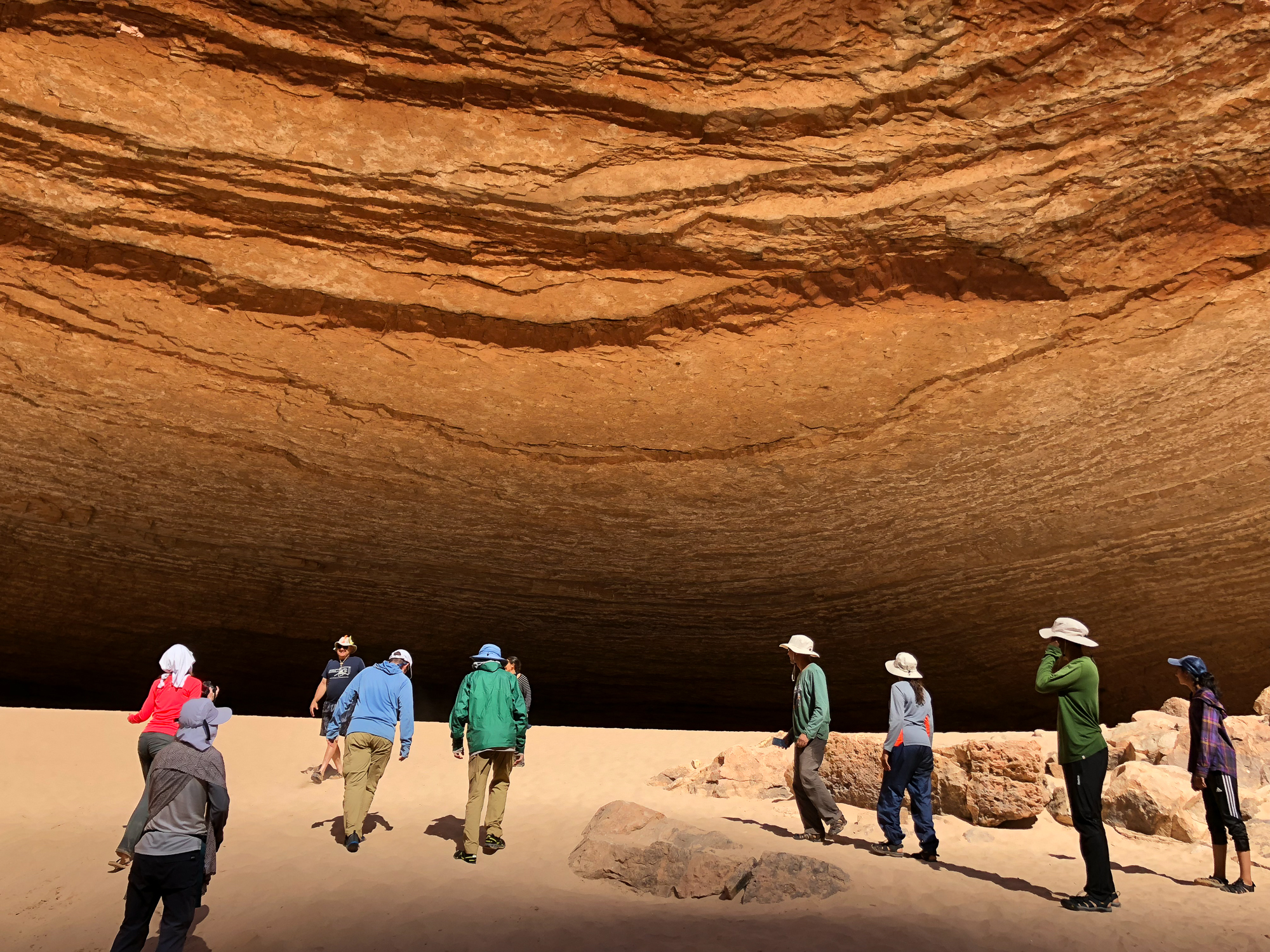


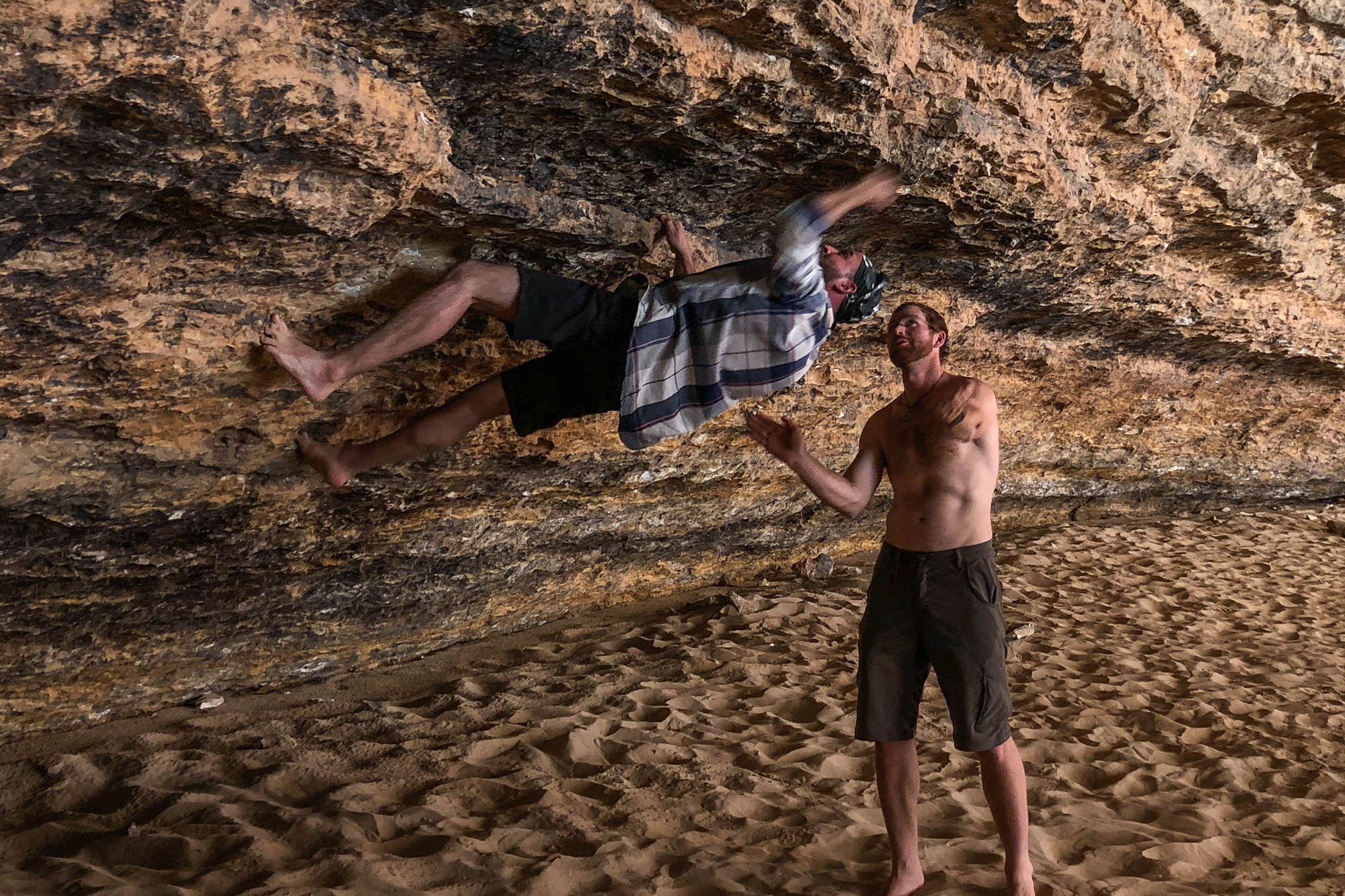

Nautiliod Camp - Night 2
We headed a few miles further downriver to camp at Nautiloid which is nicely sheltered and named for the ancient Paleozoic nautiloid fossils in the limestone. During our second night we felt a bit more experienced. We noticed the guides followed a routine in camp. They bathed and did laundry in the river as soon as the sun passed the rim. The air was still warm but the direct sun vanished. I followed their lead and incorporated these chores into my daily routine.
I laid my pad and tarp in a sheltered spot in order to enjoy another night under the stars. After 2 days of no internet, the anxious temptation to check my phone subsided. I became immersed in the timelessness of the river and I reflected on the experiences of this day. The concert in nature's amphitheater, the Redwall Cavern, the Roaring 20's, Vaseys' Paradise and the nautiloid fossils. Our trip had barely begun and it was amazing.
I settled into a camp chair and started to read my book - not a book on tape or a kindle but a book with pages of paper.

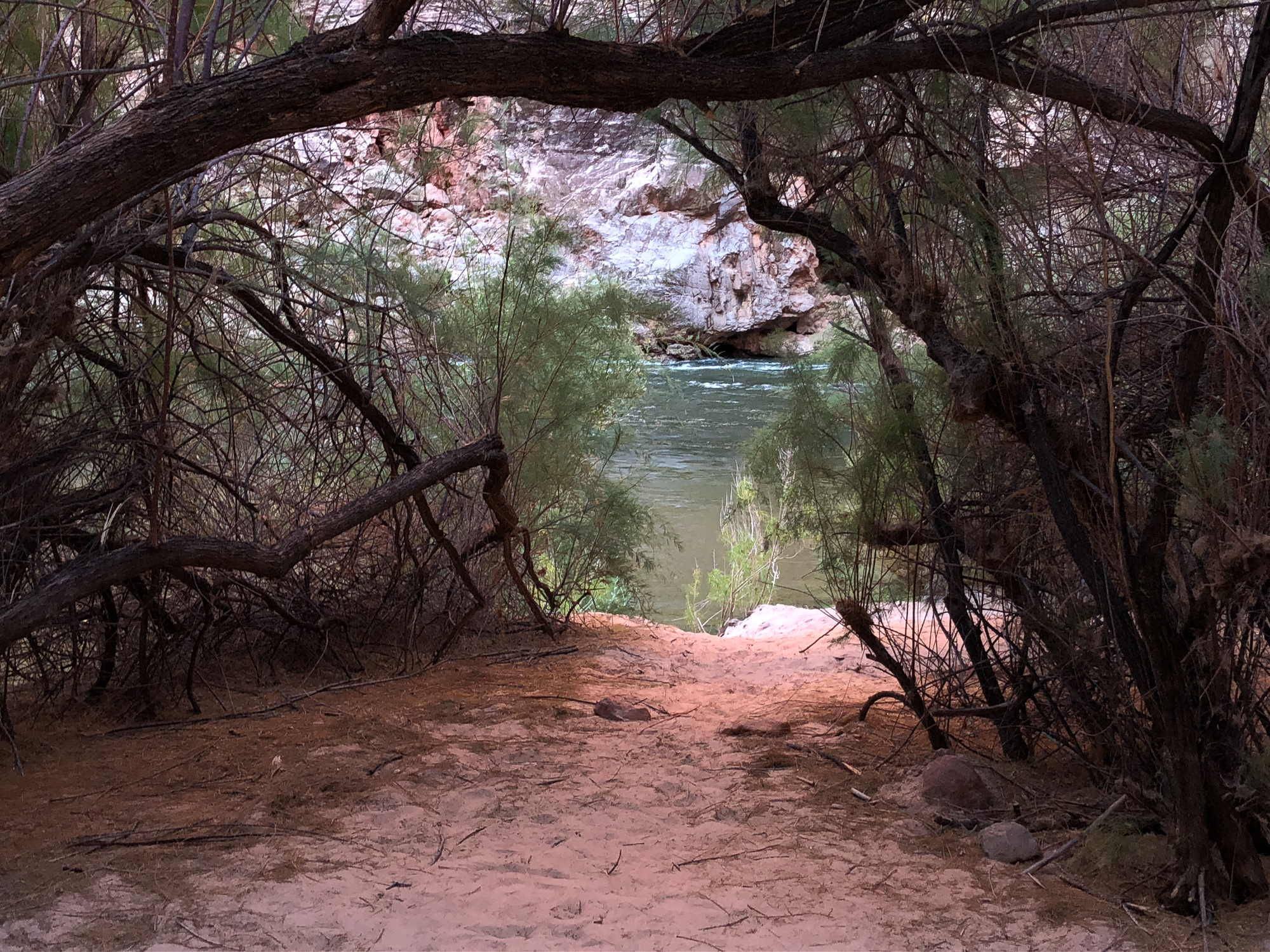



Strangers become Friends
Over the course of 2 days on the river the group of strangers transformed to friends. Common risk tends to bring people closer. No one wanted to be a burden and everyone desired to carry their own weight ... and be ready to lend a helping hand if needed. We became comfortable having deep conversations about uneasy subjects like life, death, and illness. People used to live in small self reliant groups like this. In some places on earth they still do.
Guests and guides comprised 2 different sub-groups. The guests coming from all over the world with a common yearning to experience the bottom of the Grand Canyon.
Strangers become Friends
The professional guides were a unique and diverse group of people, all choosing life experience over corporate career. Rich experiences build an uncommon depth of soul. This came out in different ways with each guide but it was a shared trait amongst them all. Cliff, our trip leader, in addition to leading river trips and working on his Ph.D. is an excellent musician. Mike Fabry has journeyed down the Canyon over 200 times. Mariah Hibarger combines rivers and yoga at Yoga by Water. Nathan Montgomery plays a hand carved apache flute, guitar and is a chocolatier. Eric is a professional rock climber, Max is a hiking guide and chef and Edith is a nutrition expert. Ruth is the mother of one of our guides. She raised 4 children with 3 riverguides in her family. Albert is a rock climber and musician from Barcelona. When speaking about the river, the guides expressed wisdom learned from experience. They respect the risk. "Guide" is an apt word for these unique and dedicated people.
Perhaps the best description of the transition from Strangers to Friends is on Nathan's OARS page. "I love the tribe that forms on every trip. There is a magic in being thrown into the depths of the canyon with a group of people that you’ve never met before and in normal circumstances would never have the chance to know. The power of traveling and living together in the wilderness is a privilege that many modern people never experience. It connects us to a way of living that we all remember deep in our bones. I just feel so dang lucky every time I’m down in the Canyon. I’m happiest there."
Days 3,4,5 - Nautiloid to Phantom Ranch - 53 miles
The Parasite - Technology
A personal transformation occured around Day 3. After 2 days off the internet, I felt different. Timelessness was the new normal. I woke with the sun. I felt the air when it moved. My smartphone lost it's FOMO power. I noticed the whispers of the canyons, sounds that were probably always there but never noticed before. With no email, I freely concentrated on bats flying overhead enforcing a "no-fly-zone" above my bed. Consciousness previously tethered to pixels on a 4 inch screen was finally free to roam. The focus of my attention was razor sharp.
In Nautiloid camp I noticed ants working on their small ant hill colony. They brought food and supplies to their home. I observed two ants working as a team to haul a large object to their ant hill. Like Sisyphus, they struggled to pull this large object up the hill only to have it slip down the sandy slope. I couldn't help but admire their determination. I realized that in my 62 years, I had never noticed a team of ants working together. I wondered if this was a fluke, or if this was something that other ants did but escaped my attention. Inspecting the anthill and saw another team, and then another. Ant teams must have always been there, but I was too distracted to notice.
The technology parasite. Photo by carloscastilla/iStock / Getty Images
Pixels have a way of capturing and controlling a person's attention. In life, attention is really all we have. Where we choose to dedicate our consciousness is the only control we have in our lives. Tech guru, Tristan Harris is on a mission warning us that people are losing the battle in the master/slave relationship of technology and user. Disconnecting technology is like disconnecting a parasite consuming your time, and your life. By day 3, the technology parasite was disconnected and I felt different. To determine who is master and who is slave in your life, try and leave your smartphone at home for a day or 2. Just try it. If you can, you are the master. If you feel anxiety then what you really feel is the venom of the technology parasite inside you, calling you back. Trying to control you.
I had a vision while watching a velvet ant (actually, a parasitic wasp) searching for its next victim. The velvet ant is covered with colorful fuzz over its body. My attention was captivated as it searched for an insect to numb with its venom, laying its eggs inside. The eggs hatching inside the live victim have a ready source of foo, eating it alive. I was mesmerized. While watching the velvet ant I imagined billions of people holding smartphones close to their faces. Their data and time consumed by Facebook, Snapchats and Tweets. With our captured attention the AI becomes more intelligent and more capable ..... the technology parasite always growing.
Is the metaphor of technology as a parasite like the velvet ant simply a metaphor or is it more? An emergent property is a "property" that spontaneously emerges from a complex system. Something like a whirlpool in a river or a cloud in the sky. The whirlpool and the cloud consist of water molecules. There is no intention with any of these water molecules to create a whirlpool or a cloud, but they do. The property of cloud and whirlpool spontaneously emerges from the system. Some people think that consciousness and life itself are emergent properties. Is the technology parasite an emergent property or just a metaphor?
Disconnecting the parasite was perhaps the most eye opening experience of this trip. An untethered attention is a marvelous thing. It is how we were designed to live.
Martin Litton and the Marble Canyon Dam
Proposed Bridge Canyon and Marble Canyon Dams on the Grand Canyon.
We departed Nautiloid and headed a few miles downriver to the site of the planned, but cancelled, Marble Canyon Dam. We hiked up a short path to a tunnel built by civil engineers in the 1940s in preparation of building this dam. Fortunately, the Marble Canyon Dam was never built because every inch of the river we had just floated for 5 days would now be buried underneath layers of silt at the bottom of a lake.
We walked into the dark tunnel which was built to test the integrity of the rock for securing the dam. With our headlamps illuminating the way, we saw blasting wire and pieces of lumber on the stone floor, remnants of construction over 70 years ago. Further back, we walked through large puddles on the tunnel's floor because of water dripping occasionally from the rock. We stopped, turned off our lights and experienced total darkness. Inside the earth we felt a sense of the sacred. We turned on our lights and walked back out the long tunnel in silence. Everyone was processing this experience, the path that could have been.
Inside the tunnel built for the Marble Canyon Dam
After a few minutes outside, our eyes adjusted and Cliff read something written by Martin Litton . It is Martin more than any other person that is credited with saving the Grand Canyon. Martin Litton was an extraordinary man. He first floated the Grand Canyon in 1955. At the age of 87 in 2004, he became the oldest person to row a boat down the Canyon. Litton served on the Board of Directors of the Sierra Club and worked to protect the wilderness for all of us. If it were not for Martin Litton, the Grand Canyon would be a series of lakes. In the 50's the US Bureau of Reclamation planned to build the Marble Canyon and Bridge Canyon Dams forever destroying the Grand Canyon. Martin fought the US government on these projects.
Martin worked to save the Canyon for all of us. He worked tirelessly to educate people about this section of earth which was remote, unseen, unknown and unappreciated. Martin knew it is impossible experience the Grand Canyon and not be awed by its magnificence. He founded Grand Canyon Dories and singlehandedly brought influential people down the river providing them a trip of a lifetime. Newspaper reporters, politicians, wealthy businessmen were his traveling companions. The word finally got out and people began caring about saving this part of the earth. A place that most people never see. The dams were stopped. Finally, in 1969 President Johnson created the Marble Canyon National Monument rather than a dam.
Grand Canyon Dories eventually became OARS. Standing in front of the Marble Canyon dam site I learned that if it was not for Martin, I would not be here. OARS would not be here. The Redwall Cavern would be underwater. The Roaring 20's would be under a lake. The slot canyon where we enjoyed our concert would be gone. The more I learned of this remarkable man, the more respect I had. Some people change the world and Martin was one of these people. The video gives you a sense of the river that Martin saved and a sense of Martin himself. It's 22 minutes long and I hope you enjoy it as much as I did.
The Granaries of Nankoweap
We camped at Nankoweap Canyon. The Ancient Puebloan people called Nankoweap home over 1000 years ago. A narrow trail from camp climbs the steep hills to the base of the redwall cliffs. At the trail's end these ancient people stored valuable seeds in granaries to protect them from animals, people and weather. The craftsmanship on the granaries was impressive. Stones used as bricks and held together with an ancient mortar. The effort to build granaries speaks to the value of the seeds. These granaries were the equivalent of a vault.
Hiking up the trail also provided with some of the best views of the Grand Canyon. The small creek exiting Nankoweap Canyon created a small, fertile delta which supported a small settlement for the ancient people. From high above I imagined these people living below safely protected from other tribes because the raging river was a moat and stone cliffs thousands of feet high were walls. What were these people like who called Nankoweap home?
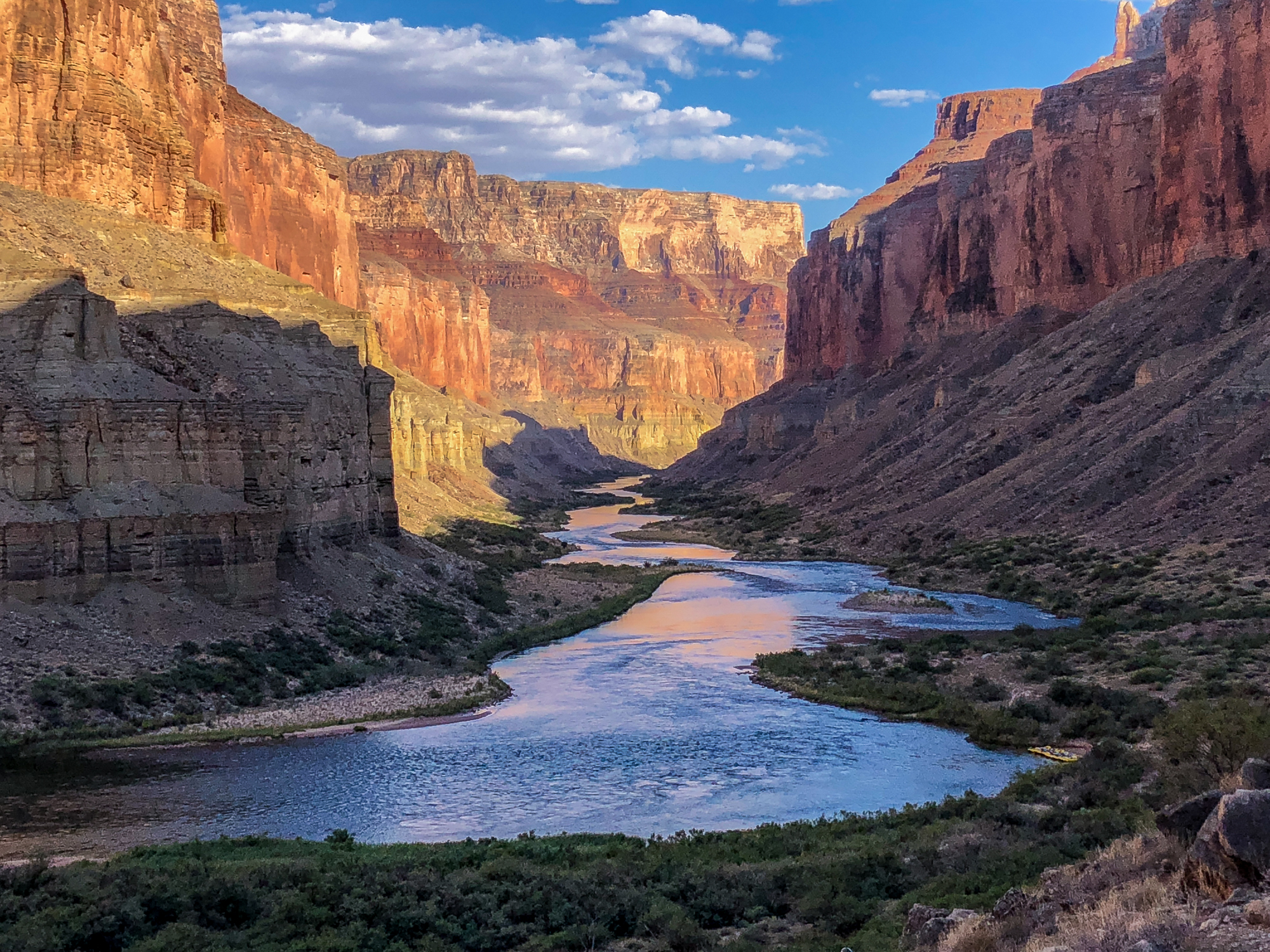


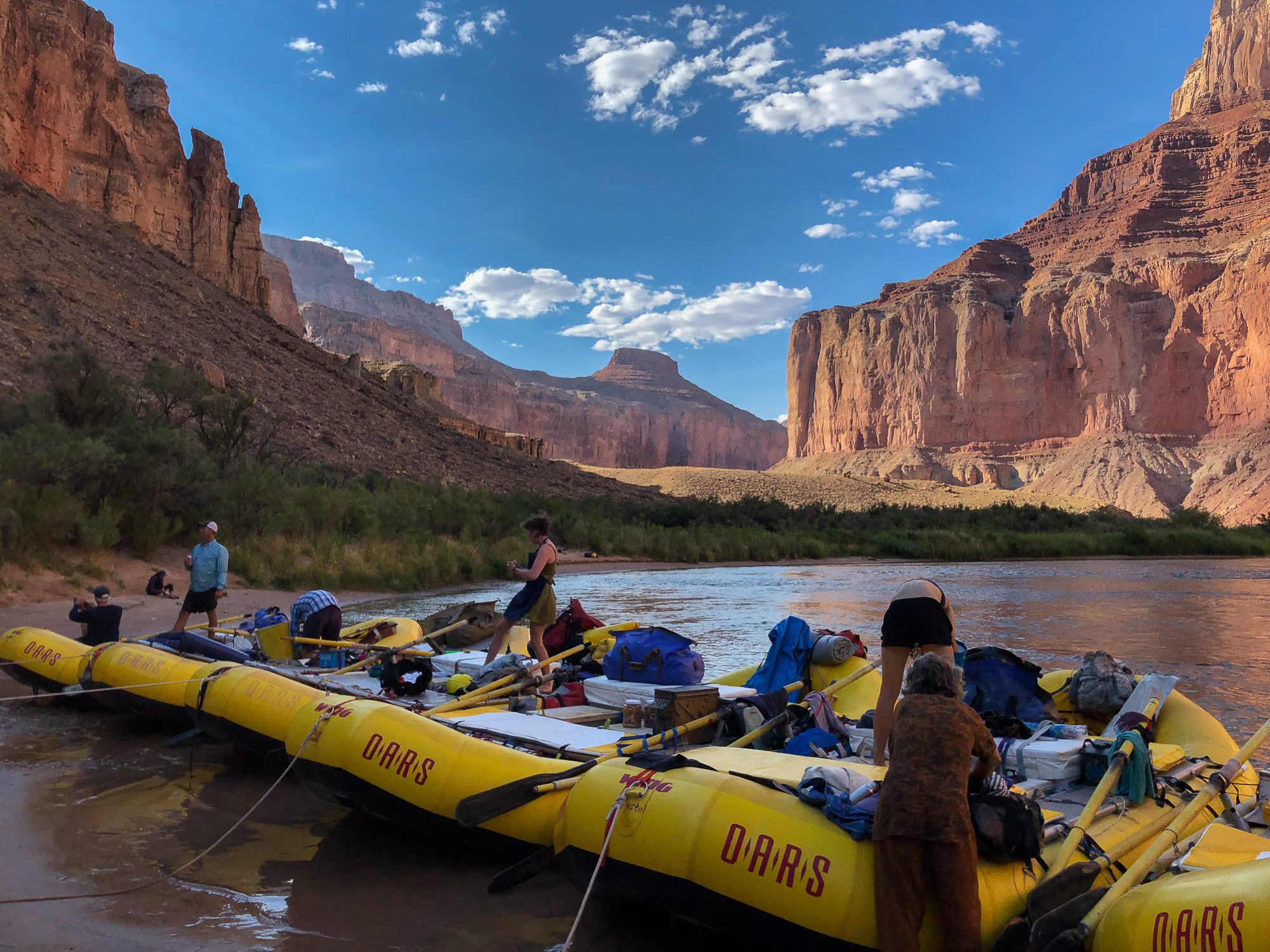
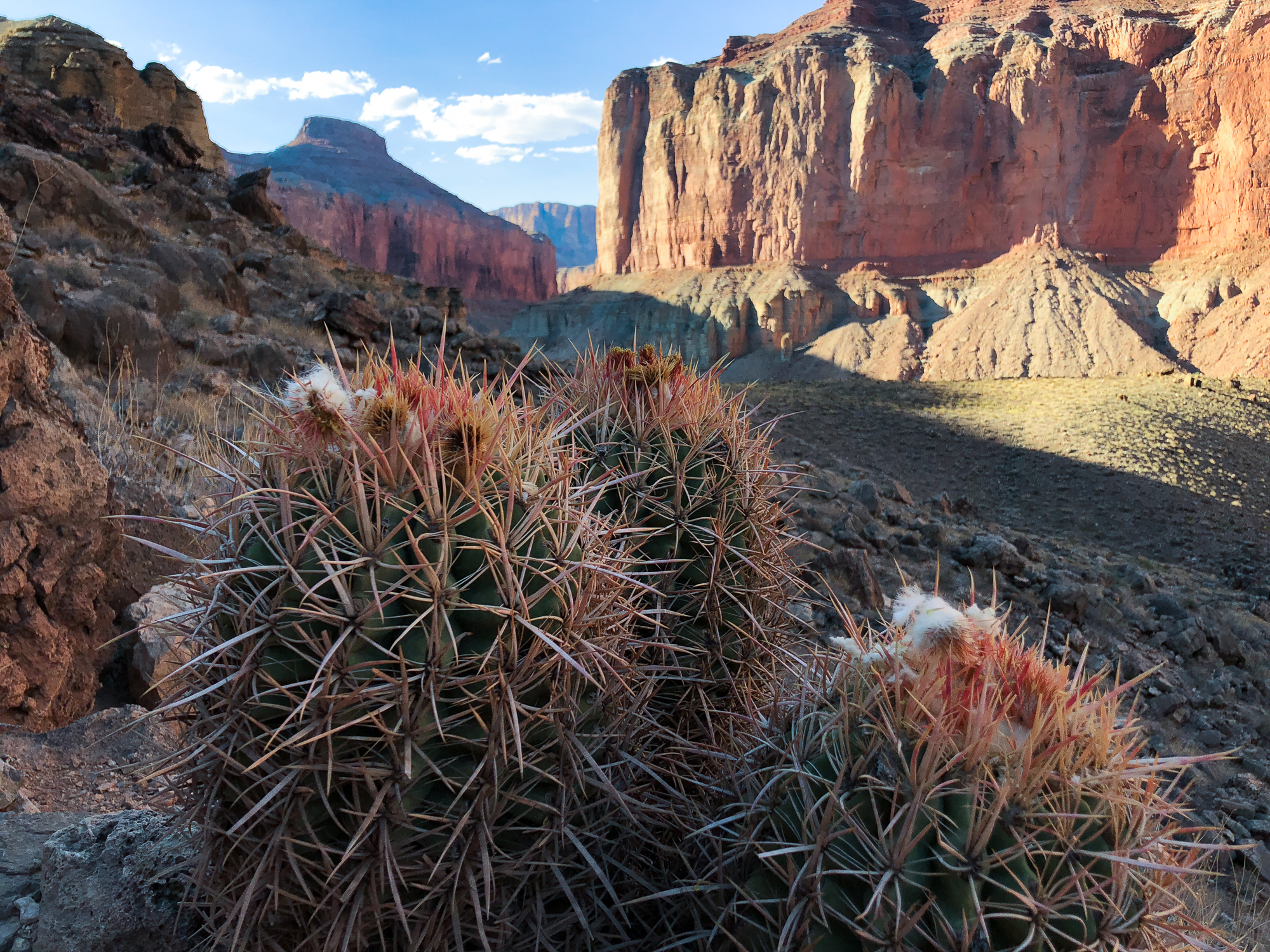
Little Colorado River
Floating down the Little Colorado
On day 4 we stopped at the Little Colorado River. For Hopi, Navajo, and Zuni tribes, the Little Colorado is sacred. The Hopi believe this is where life on earth began. The confluence of these rivers mixes turquoise blue with emerald green water. We were overcome with unworldly beauty and gazed in quiet wonder. We understood why Native Americans revere this magical sacred place.
The Little Colorado River cuts through a layer of limestone rich in calcium carbonate (chalk). The Calcium gives the water a bright turquoise blue hue while microscopic chalk particles create a milky texture. As the Little Colorado winds down the canyon, travertine dams form multitudes of infinity pools. Words cannot describe the beauty of the water.
While the Colorado River water is cool, the Little Colorado is quite warm. We swam in a Little Colorado pool. A rock served as our high dive platform and many jumped off into the milky warm water, again and again. The afternoon's swim felt fantastic. Instead of walking back to the boats, I chose to float down the river.



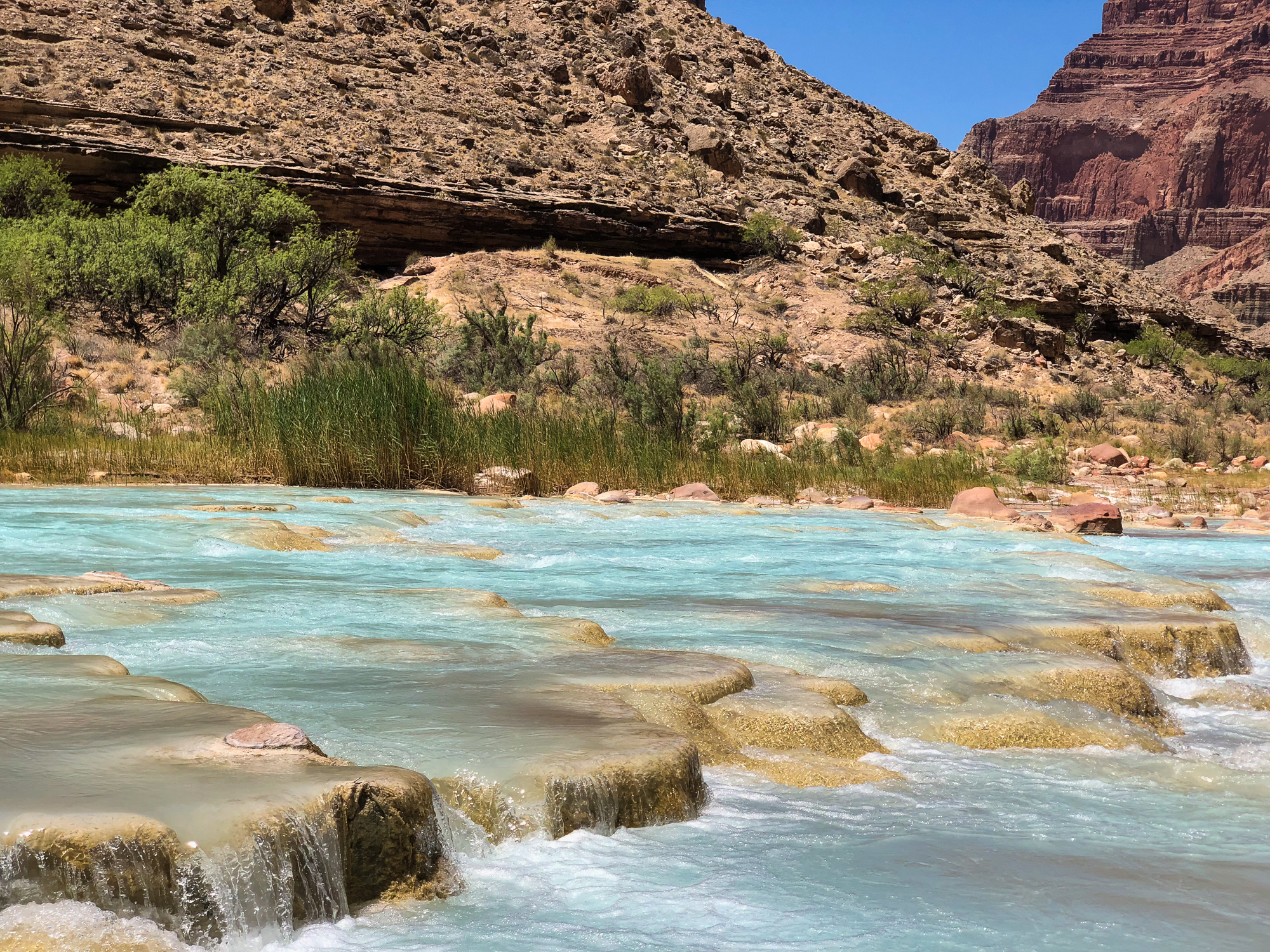
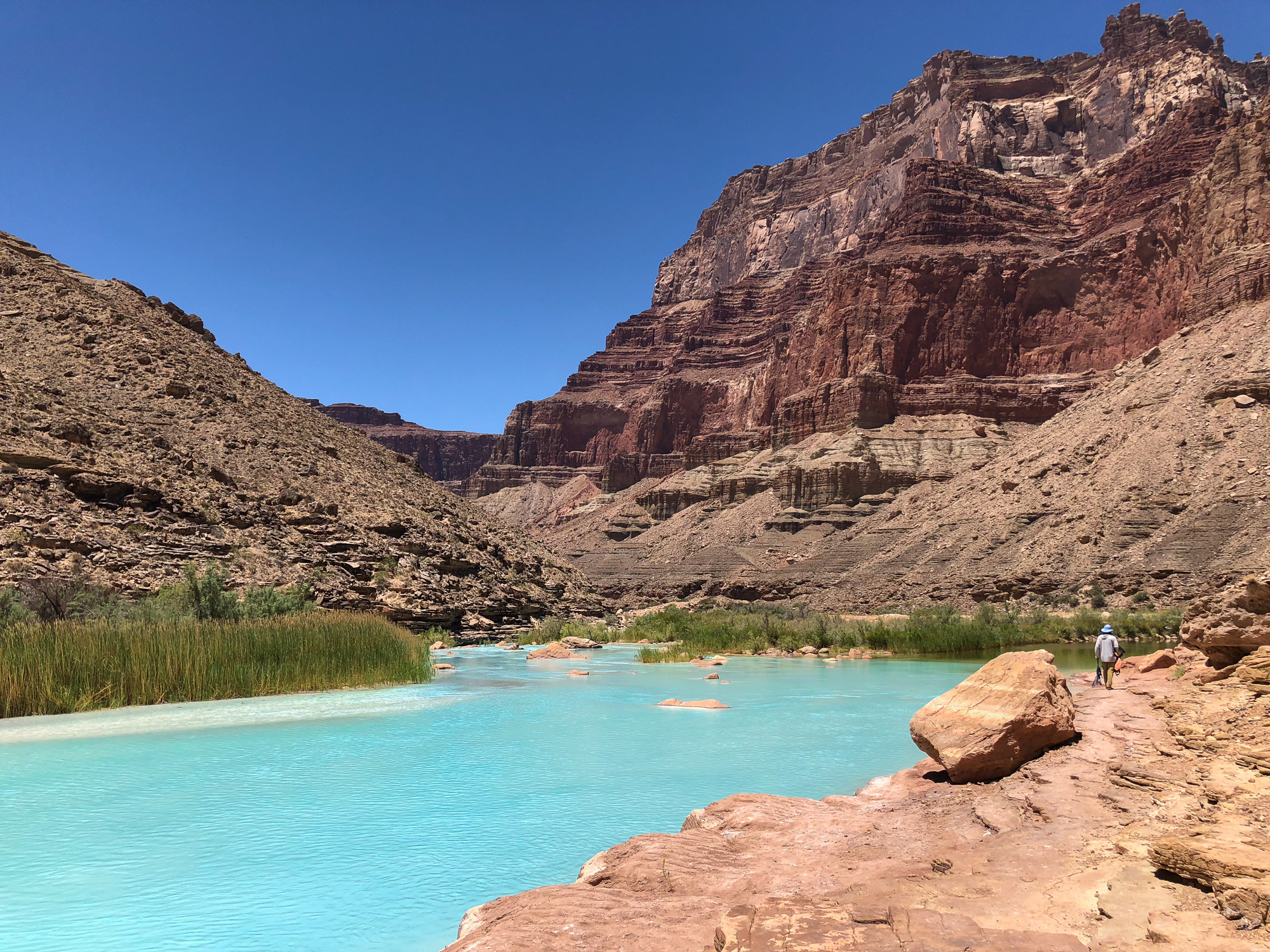
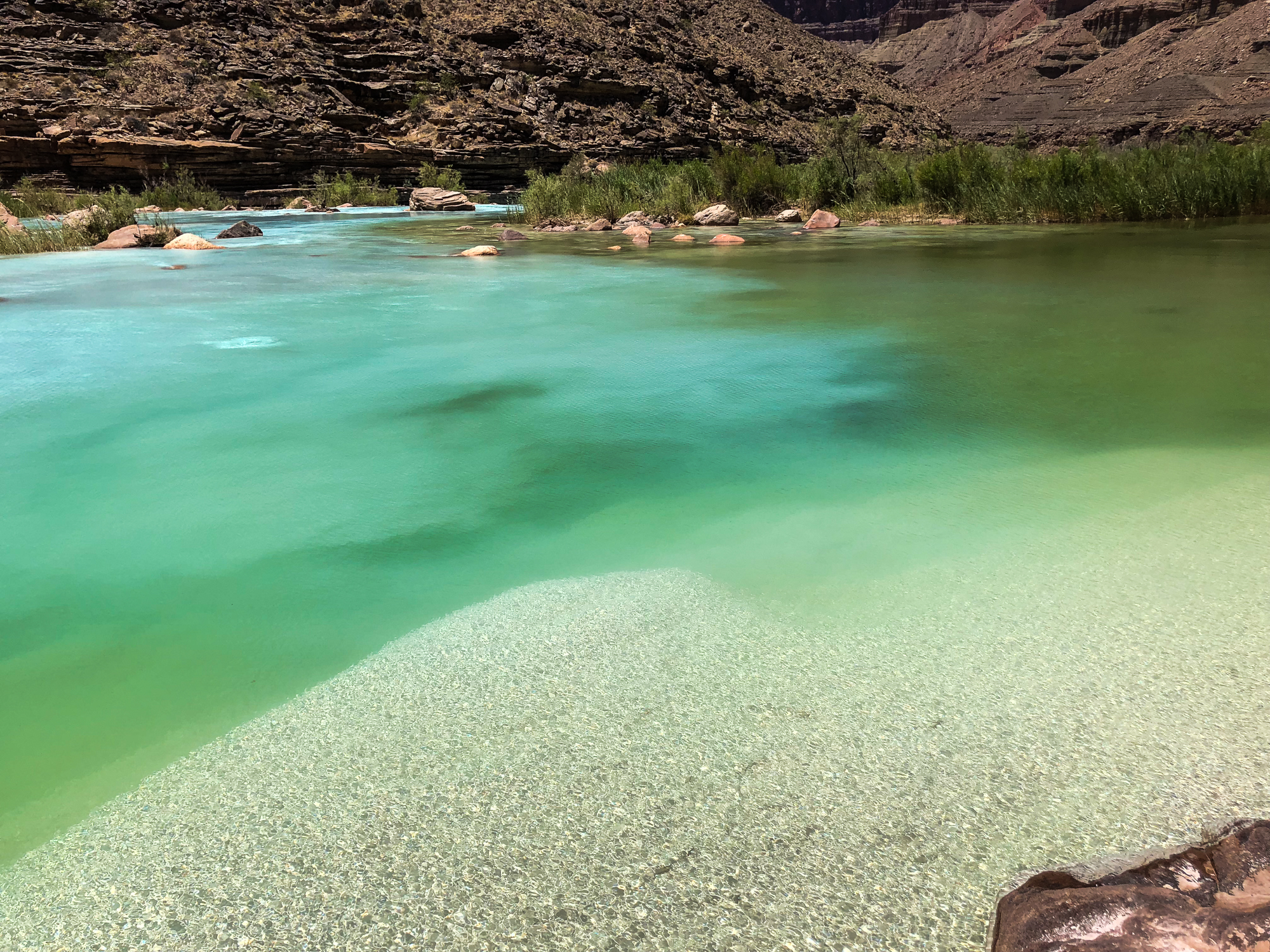

We left the confluence of the Little Colorado River and entered Furnace Flats. This section is aptly named because warm winds blow down the canyon. The guides cooled us with water cannons. Nothing like artillery streams of cold river water keep us comfortable in the a hot wind.
We camped at Rattlesnake Camp. The air was so hot we put our chairs in the river to stay cool. The confluence of hot air and cold water brought soothing comfort. I sat in the river drank a cold beer and enjoyed my book.
Granite Gorge
As we left Rattlesnake Camp on Day 5 we entered Granite Gorge which is the deepest and oldest section of the Grand Canyon. The rocks are about 2 billion years old and are a mix of metamorphic black Vishu schist and pink Zoroaster granite. The canyon here is very narrow with a unique beauty. We were overcome with awe as we glided past the unworldly cliffs with pink veins of granite snaking through ancient black stone. Perhaps there are other places where I can touch something 2 billion years old, but I have never been there.
This section of the river is indescribable. Silently we floated a mile under the earth's surface in a narrow canal with stone walls 2 billion years old. I imagined the Colorado River transformed to the River Styx winding through this un-natural beauty inside the earth.



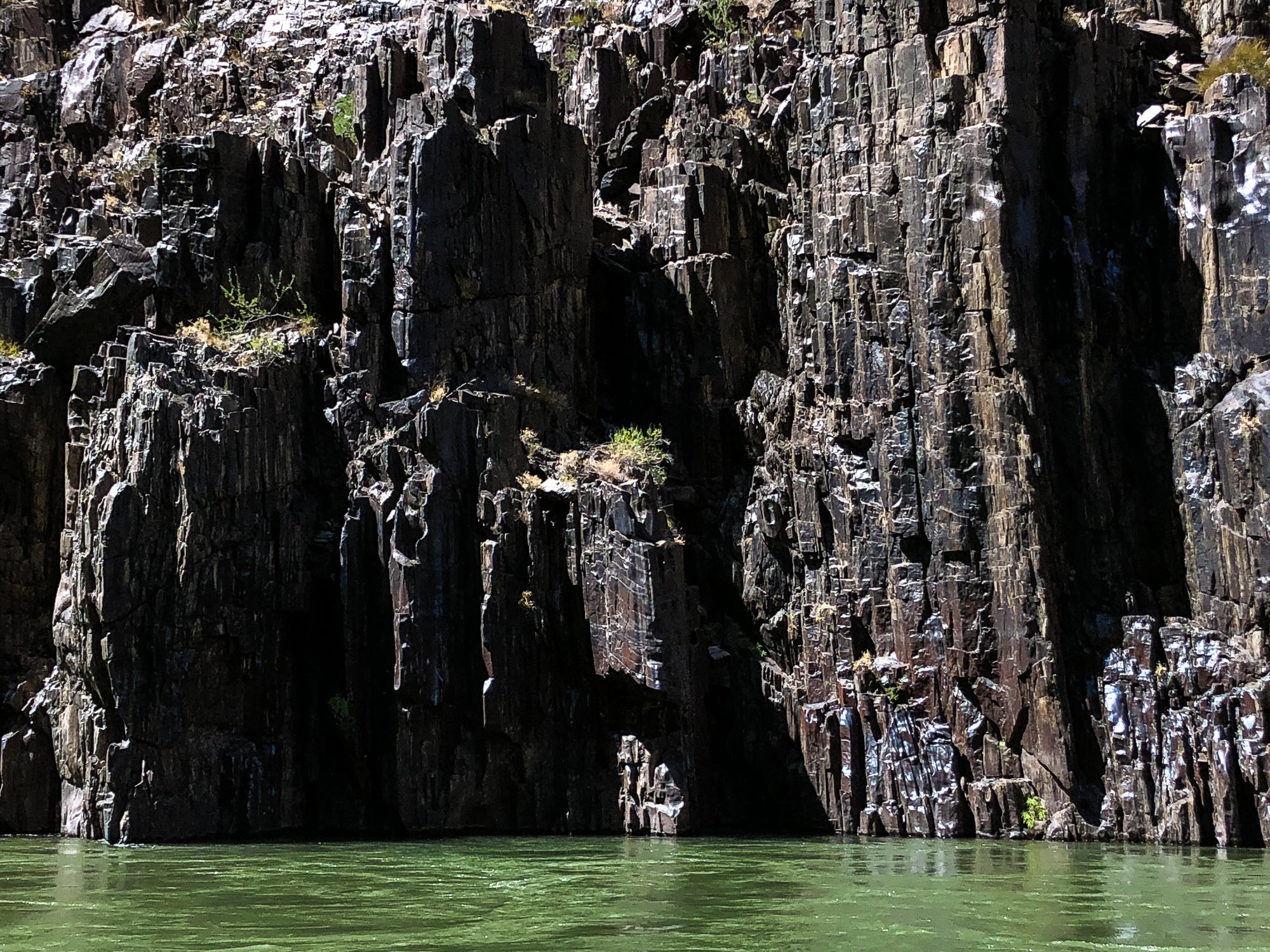
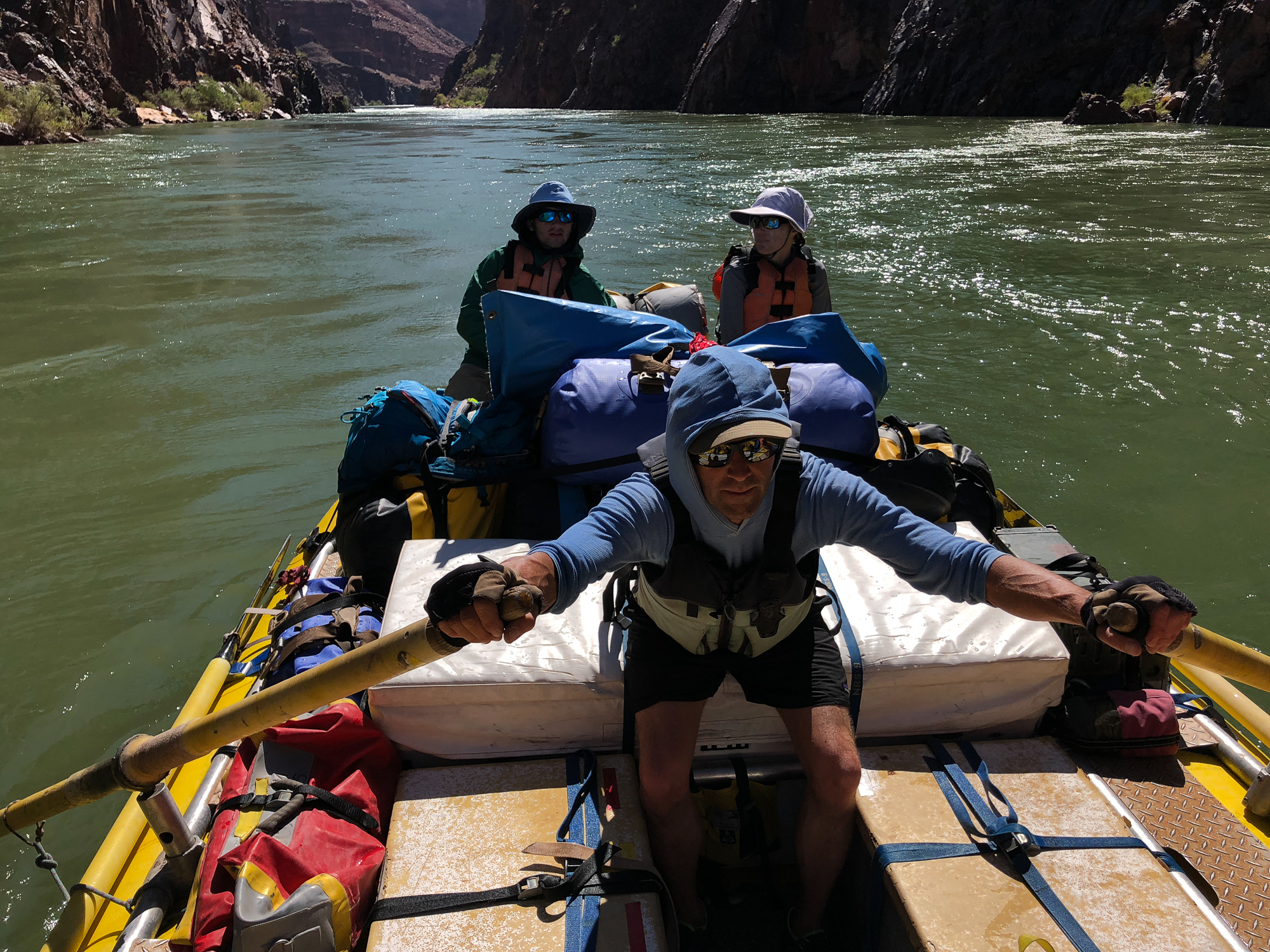

Phantom Ranch
As we floated through Granite Gorge, we realized the first half of the trip was ending. 10 guests and 1 guide left the rafts and hiked out at Phantom Ranch. Deep relationships were forged during these 5 days on the river. Everyone felt a sense of loss. But 9 new guests and 1 new guide hiked 12 miles down the Bright Angel trail and would soon join our tribe. What would these new people be like? What would the new guide be like?
We tied the rafts together and floated as a tight group. Umbrellas were put up on the rafts and sandwiches and snacks were handed out. We savored our last lunch on the water and began the process of long goodbyes. Ahead was the suspension bridge to Phantom Ranch, the first sign of civilization we had seen since we left the Navajo Bridge behind 5 days ago. As we floated under the bridge we had the bittersweet feeling that comes with turning a chapter of a great book. Something great is over, but something that may be great is about to begin.





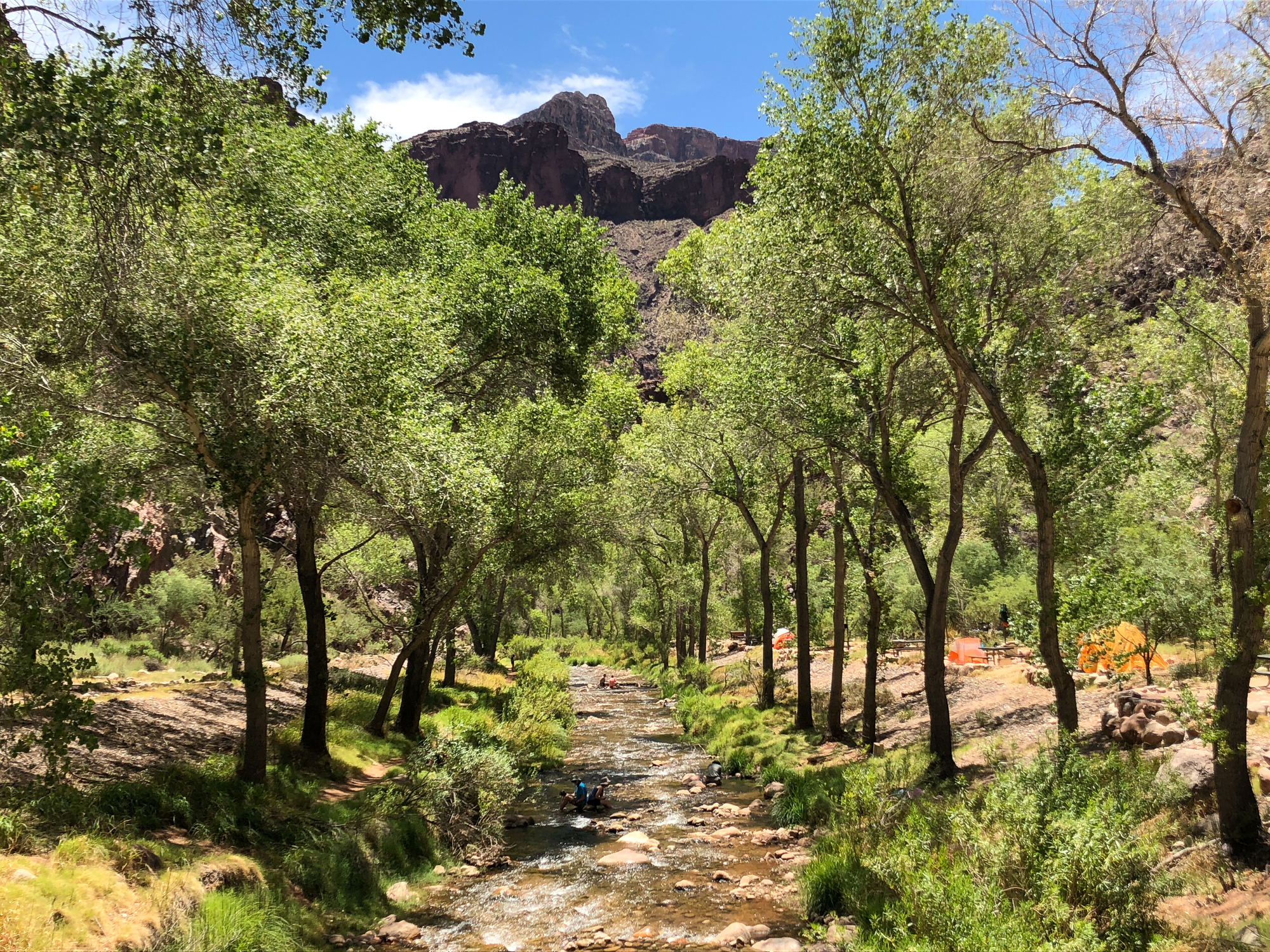

Phantom Ranch is where my journey began in December when Cheryl and I hiked the Canyon. Fond memories filled my mind. I was curious how Phantom might be different in the summer. We secured the rafts on the beach and agreed upon a departure time.
We enjoyed our 90 luxurious minutes at Phantom Ranch with ice, cold beer and even a flush toilet! But even the small village of Phantom Ranch was crowded compared to the solitude of the past 5 days. We were ready to get back on the water, meet our new friends and begin the 2nd part of our journey.
You can read part 2 - 100 miles from Phantom Ranch to Whitmore Wash and returning to civilization.


